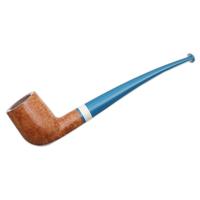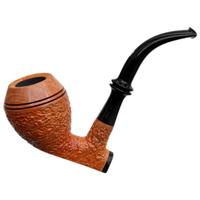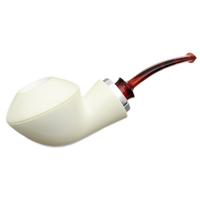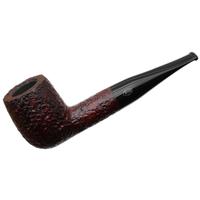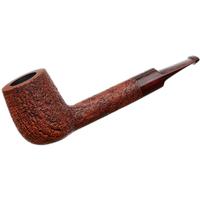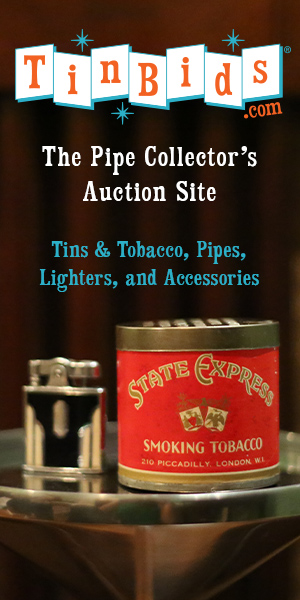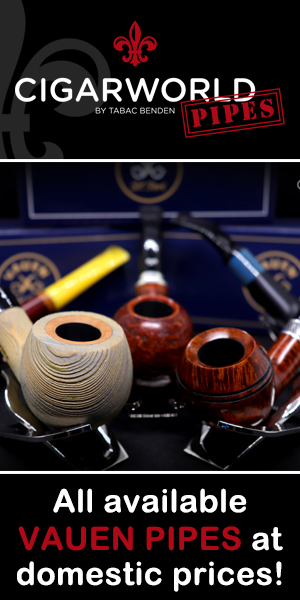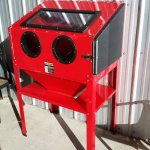This post will be meandering but I’m kind of interested in what various perspectives we might hear/read from the members on the history and art of sandblasting. I read the pipedia article on the topic, which touches on how Dunhill purportedly invented and developed the technique and what goes into it. I also watched a video of Askwith sandblasting a pipe, which really surprised me as I’d never seen it done before (looks dangerous!). What did the process look like in a 1920s Dunhill factory or a 1930s Kaywoodie factory, as opposed to how it’s done today? One thought I’ve always had is that it surprises me a bit that sandblasts are generally priced down from smooth. I know those beautiful smooth grains are rarer but sandblasts look labor-intensive to me and the outcome can be so beautiful. There’s an old thread around here where members showed their very early examples of sandblasts and discussed who really developed it. Anyone want to break out one of those pipes again to show? Do we really give all the credit to Dunhill? How about you, do you really prize your smooth beautifully-grained pipes over those masterfully blasted ones? How many ways are there these days of sandblasting and how many ways were there in the early days? Dark thought: I wonder if anyone ever lost an eye or a digit to the production a sandblasted briar…
About Sandblasting…
- Thread starter milk
- Start date
You are using an out of date browser. It may not display this or other websites correctly.
You should upgrade or use an alternative browser.
You should upgrade or use an alternative browser.
Not at all, I've even considered getting some of my straight grains sandblasted. Smooths lack the warmth and tactile appeal that I find with blasts.How about you, do you really prize your smooth beautifully-grained pipes over those masterfully blasted ones?
Being a cyclops myself, I've not heard of a carver losing an eye to a blasting cabinet and I know many of them personally.Dark thought: I wonder if anyone ever lost an eye or a digit to the production a sandblasted briar…
Dunhill didn’t invent sandblasting. That technique was around for 40 years before Dunhill existed. It required advances in controlling pressure and finding finer particulates before it could it could be applied to briar pipes. There’s also a suggestion that Dunhill initially employed another company to make the first sandblasts. Part of their process purportedly involved long exposure to heat, which caused some shrinkage between the harder and softer portions of the briar, giving the surface the appearance similar to a walnut shell, hence their use of the term “shell” on their sandblasts.
The Pipedia article could say more or be rewritten, I suppose. The implication in that article seems to be that Alfred Dunhill was the first person to think of sandblasting briar pipes. I’m interested to know more about who else was on it. I’m also curious if factories were doing different things in the early days, different methods. Sandblasting seems a bit time consuming to me. Obviously, the result is worth it in terms of the beauty of the outcome. But I guess it was a success from a sales perspective as well.Dunhill didn’t invent sandblasting. That technique was around for 40 years before Dunhill existed. It required advances in controlling pressure and finding finer particulates before it could it could be applied to briar pipes. There’s also a suggestion that Dunhill initially employed another company to make the first sandblasts. Part of their process purportedly involved long exposure to heat, which caused some shrinkage between the harder and softer portions of the briar, giving the surface the appearance similar to a walnut shell, hence their use of the term “shell” on their sandblasts.
That has always been the contradiction with blasting, its more time consuming and labor intensive than making a smooth pipe but by its nature it exists to reclaim product that otherwise could not be a smooth. There are artisan carvers who have staked their names on superior blasts and they can command some very high prices. Dunhill Shells of old can also bring more money than smooths but thats on the secondary market. There has been a lot of debate over who done it first but I have never to date seen any actual evidence that anyone used pressurized blasting prior to Dunhill in 1919. There were american companies using other methods of grain relife type rustication such as tumbling prior to 1919 but not pressurized blasting. As @sablebrush52 said the actual process of sandblasting had been around since the 1880's originally developed as a method of removing rust from iron bridges for paint and maintenance. But it was not refined enough to be used for briar until the 1920's. There's always been stories about how Alfred Dunhill "happened upon" the process by way of leaving pipes next to a heater for to long and other happenstance. I don't buy any of it, it was all marketing to give an illusion of accidental genius as opposed to an intentional solution to reclaim substandard briar with pits without using fills. It is true that oil cured pipes do produce very exceptional blasts though.
Very interesting thoughts and information on this question. I love sandblasted pipes. I just purchased a ‘30s Kaywoodie Thorn today that I can’t wait to get. Like people have said, sandblasts are great to hold in the hand and they can be very fetching. Rustication doesn’t quite do it for me. It’s interesting that Peterson leaned so hard into their rocky rustication line (I know they also have sandblasts). Is there any pipe-maker today who doesn’t do sandblasting? …or only does sandblasting?That has always been the contradiction with blasting, its more time consuming and labor intensive than making a smooth pipe but by its nature it exists to reclaim product that otherwise could not be a smooth. There are artisan carvers who have staked their names on superior blasts and they can command some very high prices. Dunhill Shells of old can also bring more money than smooths but thats on the secondary market. There has been a lot of debate over who done it first but I have never to date seen any actual evidence that anyone used pressurized blasting prior to Dunhill in 1919. There were american companies using other methods of grain relife type rustication such as tumbling prior to 1919 but not pressurized blasting. As @sablebrush52 said the actual process of sandblasting had been around since the 1880's originally developed as a method of removing rust from iron bridges for paint and maintenance. But it was not refined enough to be used for briar until the 1920's. There's always been stories about how Alfred Dunhill "happened upon" the process by way of leaving pipes next to a heater for to long and other happenstance. I don't buy any of it, it was all marketing to give an illusion of accidental genius as opposed to an intentional solution to reclaim substandard briar with pits without using fills. It is true that oil cured pipes do produce very exceptional blasts though.
Very interesting thoughts and information on this question. I love sandblasted pipes. I just purchased a ‘30s Kaywoodie Thorn today that I can’t wait to get. Like people have said, sandblasts are great to hold in the hand and they can be very fetching. Rustication doesn’t quite do it for me. It’s interesting that Peterson leaned so hard into their rocky rustication line (I know they also have sandblasts). Is there any pipe-maker today who doesn’t do sandblasting? …or only does sandblasting?
There are a few that don't do any sandblasting, like Dr Grabow does not do any sandblasting anymore. But it's pretty ubiquitous at this point. There are also some artisan carvers who don't have the equipment to blast. I think most do though.
Thorns and other early KB&Bs were the premium pipe in the US for a while. They even cost more than a Dunhill at one time. They were the largest pipe manufacturer in the world at their peak. Early thorns can be comparable in quality to Dunhill Shells but don't have the collector following that Dunhills do. Based in part to the inability to date them to specific years like Dunhills.
What shape number Thorn did you get? I collect them Specifically but these days I have a hard time finding shapes I don't already have so I pass on most of em anymore. I am still looking for a 14 though.
I don't think that it's a secret that Rad Davis still does most of the artisan blasting for them, even though he no longer makes pipes himself. I do custom bands and spigots for a few carvers, and I am always receiving them from Rad after he finishes with them. He lives just a tad further than a stones throw from me.
But, I have my own sandblasting set up for metalwork. I don't use the same medium they do, but it is the same tanks and similar nozzles. It will give you a really good abrasion if it hits your skin, but it's not as dangerous as presented. Yeh, you want to do it inside a blasting cabinet to keep it out of your eyes. The cabinet forces you to wear gloves and puts the work behind glass for you. It's a rather safe process if using the correct equipment.
But, when I have to blast the paint off of larger objects like lawnmowers (ha, which is not something I do often) you would wear gloves and goggles. I have hit my wrist with the stream a few times. It's not that bad. I am way more likely to touch touch something way hotter than I should in my studio. I have sort of increased my tolerance for heat and burns.
But, I have my own sandblasting set up for metalwork. I don't use the same medium they do, but it is the same tanks and similar nozzles. It will give you a really good abrasion if it hits your skin, but it's not as dangerous as presented. Yeh, you want to do it inside a blasting cabinet to keep it out of your eyes. The cabinet forces you to wear gloves and puts the work behind glass for you. It's a rather safe process if using the correct equipment.
But, when I have to blast the paint off of larger objects like lawnmowers (ha, which is not something I do often) you would wear gloves and goggles. I have hit my wrist with the stream a few times. It's not that bad. I am way more likely to touch touch something way hotter than I should in my studio. I have sort of increased my tolerance for heat and burns.
Well, it's an interesting question. There was a prominent pipe historian who suggested that Barling first came up with sandblasting pipes and that Dunhill stole the idea and cut them out. There's no strong evidence to support that, but there is an intriguing entry in a 1917 fancy goods catalog that lists a "Barling Nibblick". The appellation "Nibblick" was used on pre-war Barling sandblasts. But, we don't know for sure that in 1917 the term, Nibblick, applied to a sandblast because none has turned up from that period. So far, the only known Nibblicks, less than a dozen so far, have all been from the 1930's.The Pipedia article could say more or be rewritten, I suppose. The implication in that article seems to be that Alfred Dunhill was the first person to think of sandblasting briar pipes. I’m interested to know more about who else was on it. I’m also curious if factories were doing different things in the early days, different methods. Sandblasting seems a bit time consuming to me. Obviously, the result is worth it in terms of the beauty of the outcome. But I guess it was a success from a sales perspective as well.
Ian Walker (Northern Briars) does only smooth and his Rox Cut rustication.Is there any pipe-maker today who doesn’t do sandblasting? …or only does sandblasting?
Before retiring, Les Wood's Ferndown pipes were either smooth or (most frequently it seems) rusticated.
Actually, the first sandblasting patent, 108408, dates to October 18, 1870, so the technique was probably around before that. I suspect that a piece of briar subjected to this device would have been reduced to dust.That has always been the contradiction with blasting, its more time consuming and labor intensive than making a smooth pipe but by its nature it exists to reclaim product that otherwise could not be a smooth. There are artisan carvers who have staked their names on superior blasts and they can command some very high prices. Dunhill Shells of old can also bring more money than smooths but thats on the secondary market. There has been a lot of debate over who done it first but I have never to date seen any actual evidence that anyone used pressurized blasting prior to Dunhill in 1919. There were american companies using other methods of grain relife type rustication such as tumbling prior to 1919 but not pressurized blasting. As @sablebrush52 said the actual process of sandblasting had been around since the 1880's originally developed as a method of removing rust from iron bridges for paint and maintenance. But it was not refined enough to be used for briar until the 1920's. There's always been stories about how Alfred Dunhill "happened upon" the process by way of leaving pipes next to a heater for to long and other happenstance. I don't buy any of it, it was all marketing to give an illusion of accidental genius as opposed to an intentional solution to reclaim substandard briar with pits without using fills. It is true that oil cured pipes do produce very exceptional blasts though.
Here's a link to some of the early US patents related to sandblasting technology:
Sandblasting Pioneers List of sandblasting inventors Vancouver sandblasting services
Here's a link to Wheelabrator, the company that Benjamin Tilghman, who wrote the 1870 patent application, founded:
Who invented airblasting and wheelblasting? Wheelabrator was influential in the creation of the surface preparation industry. Read more online here.
Who invented airblasting and wheelblasting? Wheelabrator was influential in the creation of the surface preparation industry. Read more online here.
Early Sandblasted Pipes - Many Unknowns Yet Remain :: Tobacciana History
The early history of the sandblasted pipe remains pretty fuzzy, but the general thought among most collectors is that its origin dates to 1917 with Alfred Dunhill - - although there is some dissent on the topic, most notably from ebay seller Mr. Can, who has stated: "First, as a historical...
pipesmagazine.com
For the longest time I thought that Reiss Premier and/or KB&B were in fact sandblasting before Dunhill, and had more than few conversations with Tony Soderman about it as he asserted the same thing. I have more than a few very early american blasts but none that I can prove were done before 1918-19. I think there is some confusion there as well about patents vs trademarks. I do know for a fact that pipes were being sandblasted in the US as early as 1920 but just haven't seen any hard evidence that indicates any of them predate 1918Actually, the first sandblasting patent, 108408, dates to October 18, 1870, so the technique was probably around before that. I suspect that a piece of briar subjected to this device would have been reduced to dust.
Here's a link to some of the early US patents related to sandblasting technology:
Sandblasting Pioneers List of sandblasting inventors Vancouver sandblasting services
www.allweldsandblasting.com
Here's a link to Wheelabrator, the company that Benjamin Tilghman, who wrote the 1870 patent application, founded:
And here's a discussion about early sandblasts on this here magazine:Who invented airblasting and wheelblasting? Wheelabrator was influential in the creation of the surface preparation industry. Read more online here.
Who invented airblasting and wheelblasting? Wheelabrator was influential in the creation of the surface preparation industry. Read more online here.www.wheelabratorgroup.com
Early Sandblasted Pipes - Many Unknowns Yet Remain :: Tobacciana History
The early history of the sandblasted pipe remains pretty fuzzy, but the general thought among most collectors is that its origin dates to 1917 with Alfred Dunhill - - although there is some dissent on the topic, most notably from ebay seller Mr. Can, who has stated: "First, as a historical...pipesmagazine.com
It was Tony who asserted, in one of our conversations, that Barling had preceded Dunhill with sandblasting and that ol' Alfred had stolen the idea.For the longest time I thought that Reiss Premier and/or KB&B were in fact sandblasting before Dunhill, and had more than few conversations with Tony Soderman about it as he asserted the same thing. I have more than a few very early american blasts but none that I can prove were done before 1918-19. I think there is some confusion there as well about patents vs trademarks. I do know for a fact that pipes were being sandblasted in the US as early as 1920 but just haven't seen any hard evidence that indicates any of them predate 1918
There's just not enough documentation that's come to light to answer these questions. Maybe something new will show up.
In the meantime, keep a healthy skepticism around any blanket claims. People lie. Constantly. Especially if there's either money or sexual reward involved.
It was Tony who asserted, in one of our conversations, that Barling had preceded Dunhill with sandblasting and that ol' Alfred had stolen the idea.
Tony's specialty was deciding something, then fighting like a pit bull forevermore about the point regardless of evidence to the contrary. Full refutation by direct, firsthand demonstration had no effect.
I found it difficult to take him seriously regarding any subject after discovering that.
Which is not to say he didn't know stuff... Rather, that HE didn't know what he ACTUALLY knew. (Emotion and facts rarely cohabitate)
So it was a lie when she said "I love you for your mind" and "you have nice earlobes"?People lie. Constantly. Especially if there's either money or sexual reward involved.
Mind blown.
I've not heard this before. Is it Glass?Being a cyclops myself, I've not heard of a carver losing an eye to a blasting cabinet and I know many of them personally.
Our right or yours?Yep! I've mentioned it a couple of times on here. Lost it to the same explosion that wrecked my teeth. It's the right one.
View attachment 246805



